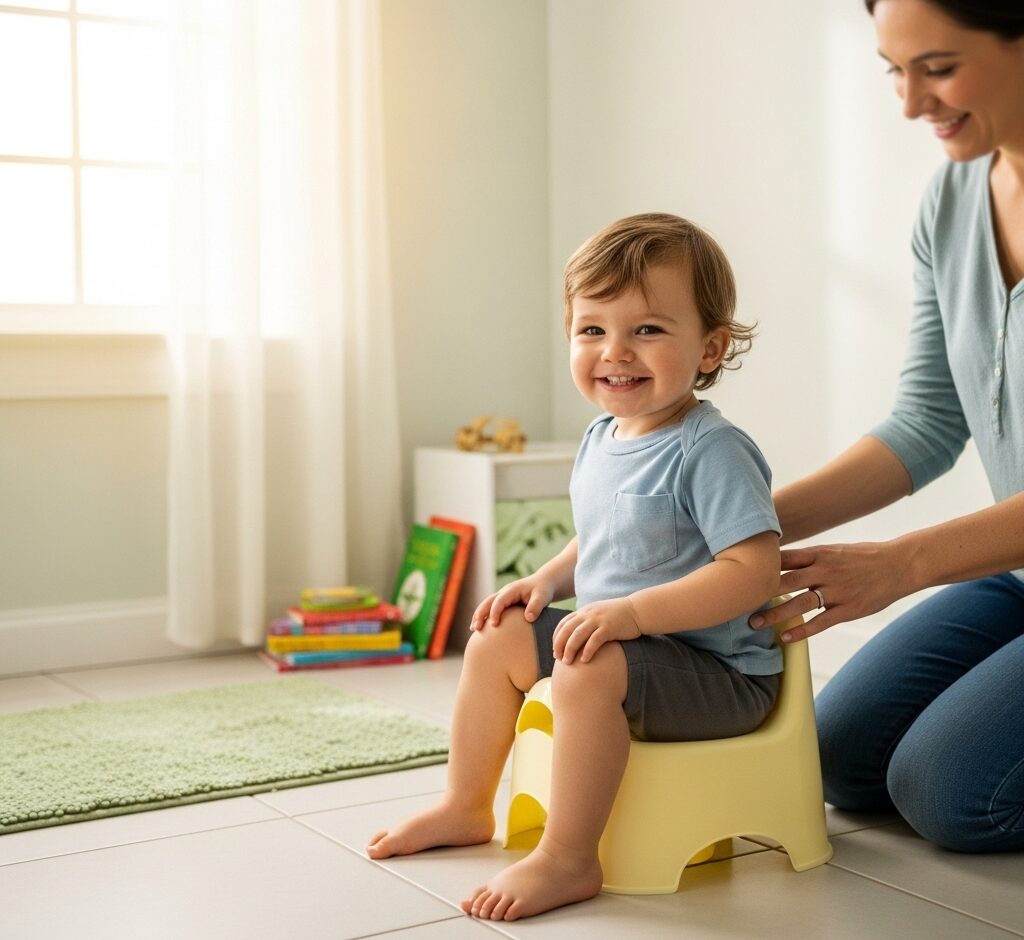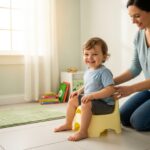The Ultimate Guide to Potty Training Your Toddler: A Parent’s Roadmap to Success
- November 24, 2025
- 0

Potty training.The Ultimate Guide to Potty Training Just the words can send shivers down a parent’s spine. It’s a significant milestone in your toddler’s development, and it can feel overwhelming. But fear not! This comprehensive guide is designed to equip you with the knowledge, strategies, and patience you need to navigate this journey successfully. We’ll break down the process into manageable steps, address common challenges, and offer practical tips to make potty training a positive experience for both you and your little one.
Table of Contents
Main topics The Ultimate Guide to Potty Training
This guide will cover the following key areas:
- Readiness Assessment: Determining if your toddler is truly ready for potty training.
- Choosing the Right Method: Exploring different potty training approaches and selecting one that aligns with your child’s personality and your family’s lifestyle.
- Setting the Stage: Preparing your home and creating a comfortable and supportive environment.
- The Potty Training Process: Step-by-step instructions and techniques for introducing the potty, encouraging use, and handling accidents.
- Troubleshooting Common Issues: Addressing setbacks, resistance, and other challenges that may arise.
- Nighttime Potty Training: Strategies for achieving dryness overnight.
- Maintaining Consistency: Ensuring continued success after the initial training period.
Readiness Assessment
The Ultimate Guide to Potty Training
Before diving into the world of potty training, it’s crucial to assess your toddler’s readiness. Starting too early can lead to frustration and prolonged training. Look for these signs:
Physical Readiness The Ultimate Guide to Potty Training
- Bladder Control: Can your toddler stay dry for at least two hours during the day? This indicates that their bladder muscles are developing.
- Predictable Bowel Movements: Does your child have bowel movements around the same time each day? This predictability makes it easier to anticipate when they need to go.
- Gross Motor Skills: Can your toddler walk to the potty, sit down, and get up independently?
- Fine Motor Skills: Can your toddler pull down their pants and pull them up again? This independence is key to success.
Cognitive Readiness The Ultimate Guide to Potty Training
- Understanding Instructions: Can your toddler follow simple instructions, such as “Pick up the toy” or “Bring me the book”?
- Understanding the Concept of “Potty”: Do they understand what the potty is for and what it means to go to the bathroom?
- Expressing Needs: Can your toddler communicate when they need to go, either verbally or through gestures?
- Interest in Using the Toilet: Do they show curiosity about the toilet or ask to watch you use it?
Emotional Readiness to the The Ultimate Guide to Potty Training
- Desire to Please: Is your toddler eager to please you and follow your instructions?
- Imitation: Do they enjoy imitating your actions, such as pretending to brush their teeth or wash their hands?
- Independence: Are they becoming more independent and wanting to do things on their own?
- Discomfort with Dirty Diapers: Do they show signs of discomfort when their diaper is wet or soiled, such as pulling at it or asking to be changed?
What if my toddler isn’t showing all the signs?
It’s perfectly normal for toddlers to The Ultimate Guide to Potty Trainingdevelop at different paces. If your child isn’t showing all the readiness signs, it’s best to wait a few weeks or months and try again. Pushing them before they’re ready can be counterproductive. Focus on building a positive association with the potty and continue observing for signs of readiness.
Choosing the Right Method
There’s no one-size-fits-all approach to potty training. Several methods exist, each with its own advantages and disadvantages. Consider your child’s personality, your lifestyle, and your own preferences when choosing a method.
The Child-Oriented Approach
- Description: This method emphasizes following your child’s lead and allowing them to progress at their own pace. It involves observing your child for readiness signs, introducing the potty, and encouraging them to use it when they show interest.
- Pros: Gentle, less stressful for both parent and child, promotes independence.
- Cons: Can be slower than other methods, requires patience and flexibility.
- Example: Let your child sit on the potty fully clothed while you read them a book. Gradually introduce the idea of using it when they feel the urge to go.
The Intensive (3-Day) Approach to the Ultimate Guide to Potty Training
- Description: This method involves dedicating a few days to focused potty training. You’ll spend the entire time at home, reminding your child to use the potty frequently and providing positive reinforcement.
- Pros: Can be quicker than other methods, provides a structured and consistent approach.
- Cons: Requires significant time commitment, can be stressful for some children, may not be suitable for all personalities.
- Example: On day one, remove diapers completely. Offer plenty of fluids and remind your child to use the potty every 20-30 minutes. Celebrate successes with praise and small rewards.
The Scheduled Potty Breaks Approach
- Description: This method involves taking your child to the potty at regular intervals throughout the day, regardless of whether they indicate they need to go.
- Pros: Can be helpful for children who have difficulty recognizing their body’s signals, provides a structured routine.
- Cons: Can be less responsive to your child’s individual needs, may require more prompting from the parent.
- Example: Take your child to the potty every two hours, even if they haven’t asked to go. If they’re successful, offer praise and a small reward.
The Elimination Communication (EC) Approach
- Description: This method involves observing your baby’s cues and offering them the opportunity to eliminate in a potty or toilet from a very young age (often before they can even sit up).
- Pros: Can lead to early potty independence, promotes a strong connection between parent and child.
- Cons: Requires significant time and commitment, may not be suitable for all families.
- Example: Observe your baby for signs that they need to eliminate, such as grunting or squirming. Hold them over a potty or toilet and make a specific sound (e.g., “psss”) to associate with urination.
Hybrid Approaches
Many parents find that a combination of methods works best for their child. You might start with a child-oriented approach and then incorporate scheduled potty breaks to provide more structure. Don’t be afraid to adapt your approach as needed to meet your child’s individual needs.
:Setting the Stage
Creating a comfortable and supportive environment is essential for successful potty training.
Gather Your Supplies
- Potty Chair or Toilet Seat Reducer: Choose one that is comfortable and stable for your child. Let them help pick it out to make them feel more involved.
- Step Stool: If using a toilet seat reducer, a step stool will help your child reach the toilet independently.
- Training Pants: These are absorbent underwear that can help catch accidents while still allowing your child to feel wetness.
- Wipes: Essential for cleaning up accidents.
- Change of Clothes: Keep several sets of clothes readily available.
- Books and Toys: Provide distractions to keep your child entertained while sitting on the potty.
- Rewards: Small, non-food rewards, such as stickers, small toys, or praise, can be motivating.
- Waterproof Mattress Protector: Protect your child’s mattress from nighttime accidents.
Prepare the Environment
- Make the Potty Accessible: Place the potty chair in a convenient location, such as the bathroom or a playroom.
- Create a Comfortable Space: Ensure the bathroom is warm and inviting.
- Introduce the Potty: Let your child explore the potty and get comfortable with it. Explain what it’s for in simple terms.
- Read Potty Training Books: Books can help normalize the process and make it more relatable for your child.
- Talk About Potty Training: Discuss potty training with your child in a positive and encouraging way.
Involve Your Child
- Let them choose their potty chair or training pants.
- Have them help you empty the potty.
- Read potty training books together.
- Praise their efforts, even if they don’t always succeed.
The Potty Training Process
Now it’s time to put your plan into action!
Introducing the Potty
- Start with Dry Runs: Have your child sit on the potty fully clothed for a few minutes each day.
- Explain the Process: Show them how to pull down their pants, sit on the potty, and wipe themselves.
- Associate with Elimination: When your child has a bowel movement in their diaper, empty it into the potty and explain that this is where poop goes.
- Make it Fun: Sing songs, read books, or play games while they’re sitting on the potty.
Encouraging Use
- Offer Frequent Reminders: Remind your child to use the potty every 20-30 minutes, especially in the beginning.
- Watch for Cues: Pay attention to your child’s body language and look for signs that they need to go, such as squirming, holding themselves, or grunting.
- Praise Successes: When your child uses the potty successfully, offer enthusiastic praise and a small reward.
- Avoid Pressure: Don’t force your child to sit on the potty if they don’t want to. This can create negative associations and make them resistant to potty training.
Handling Accidents
- Stay Calm: Accidents are a normal part of the potty training process. Avoid getting angry or frustrated.
- Clean Up Quickly: Clean up the accident calmly and efficiently.
- Change Clothes: Help your child change into clean clothes.
- Remind Them of the Potty: Remind them that the potty is where pee and poop go.
- Don’t Punish: Punishing your child for accidents can be counterproductive and damage their self-esteem.
H2: Troubleshooting Common Issues
Potty training isn’t always smooth sailing. Here are some common challenges and how to address them:
H3: Resistance to Using the Potty
- Possible Causes: Fear, anxiety, lack of control, negative associations.
- Solutions: Back off and try again later, make the potty more appealing, offer choices, read books about potty training, consult with your pediatrician.
Holding It In
- Possible Causes: Fear of the potty, constipation, desire for control.
- Solutions: Encourage fluids, offer fiber-rich foods, address constipation, make the potty more comfortable, use positive reinforcement.
Frequent Accidents
- Possible Causes: Not recognizing body signals, bladder control issues, excitement, distraction.
- Solutions: Offer frequent reminders, watch for cues, limit distractions, practice bladder control exercises, consult with your pediatrician.
Regression
- Possible Causes: Stress, illness, changes in routine, new sibling.
- Solutions: Be patient and understanding, offer extra support and encouragement, address the underlying cause of the regression, go back to basics if needed.
When to Seek Professional Help
If you’re concerned about your child’s potty training progress, or if they’re experiencing significant difficulties, consult with your pediatrician. They can rule out any underlying medical conditions and offer guidance and support.
Nighttime Potty Training
Nighttime potty training typically comes after daytime training is well established.
Readiness for Nighttime Training
- Staying Dry During Naps: If your child is consistently waking up dry from naps, they may be ready for nighttime training.
- Waking Up Dry Most Mornings: If they are waking up dry most mornings, this is another good sign.
- Asking to Wear Underwear at Night: Expressing a desire to wear underwear at night is a sign of readiness.
Strategies for Nighttime Training
- Limit Fluids Before Bed: Avoid giving your child large amounts of fluids in the hour or two before bedtime.
- Potty Before Bed: Make sure your child uses the potty right before going to bed.
- Use a Waterproof Mattress Protector: Protect your child’s mattress from accidents.
- Consider a Nightlight: A nightlight can help your child find the potty in the dark.
- Praise Successes: If your child wakes up dry, offer praise and encouragement.
- Handle Accidents Calmly: If your child has an accident, clean it up calmly and reassure them that it’s okay.
Patience is Key
Nighttime potty training can take longer than daytime training. Be patient and supportive, and don’t get discouraged by setbacks.
Maintaining Consistency
Consistency is crucial for long-term potty training success.
Sticking to the Routine
- Continue to offer frequent reminders.
- Maintain a consistent bedtime routine.
- Use the same language and cues.
- Be consistent with rewards and praise.
Potty Training on the Go
- Pack a potty training kit with extra clothes, wipes, and a portable potty.
- Plan potty breaks ahead of time.
- Use public restrooms when necessary.
- Be prepared for accidents.
Celebrate the Milestone
Potty training is a significant accomplishment for both you and your child. Celebrate this milestone with a special treat or activity.
Potty training is a journey, not a race. Be patient, supportive, and understanding, and remember that every child learns at their own pace. With the right approach and a little bit of perseverance, you and your toddler can successfully navigate this important milestone. Good luck!








